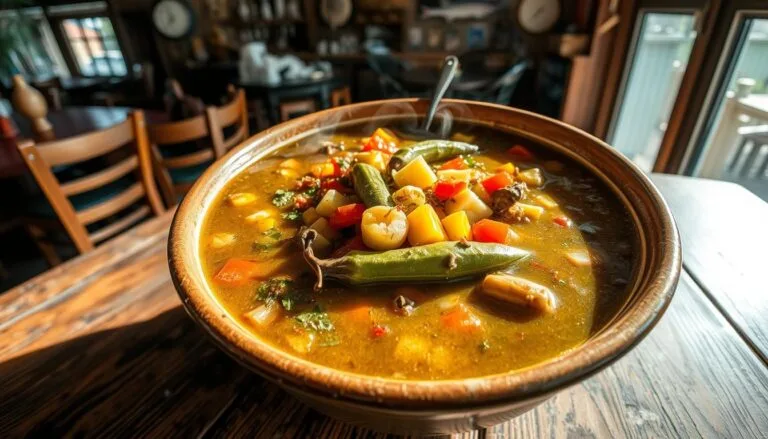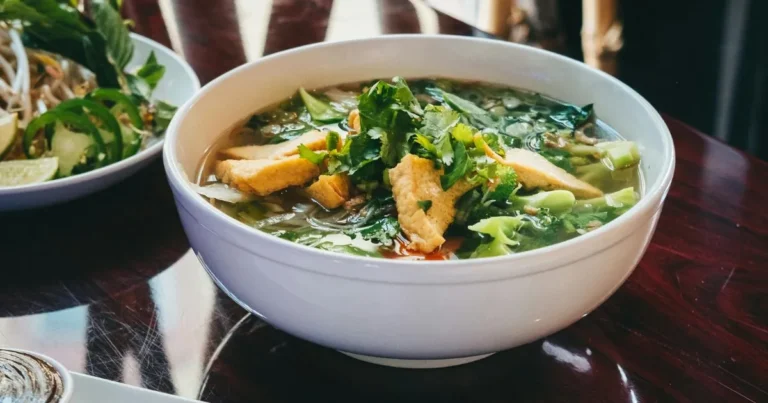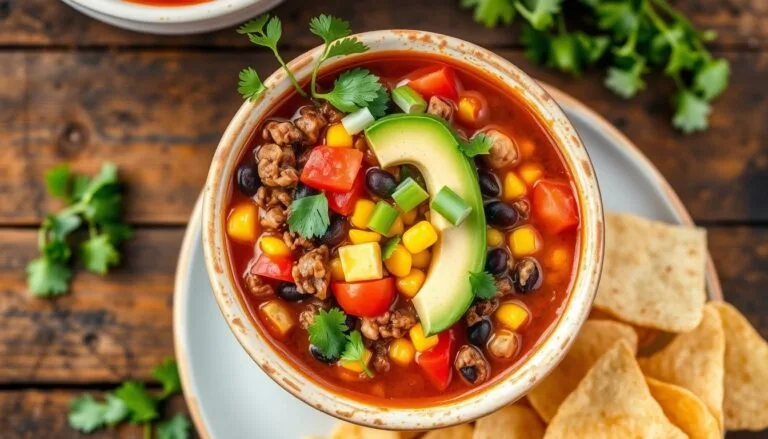Tips for Preparing the Best Vegetable Beef Soup Quickly
When winter winds howl and hunger strikes, nothing comforts quite like a steaming bowl of easy vegetable and beef soup. I remember my grandmother’s kitchen, filled with the rich aroma of simmering beef and vegetables. It transformed simple ingredients into a meal that warmed both body and soul.
Creating a quick soup recipe doesn’t mean sacrificing flavor. With just 10 minutes of preparation, you can craft a hearty vegetable and beef soup that rivals slow-cooked classics. Modern home cooks need smart techniques that deliver maximum taste with minimal time investment.
This guide will walk you through crafting the perfect quick soup recipe. You’ll learn how to select the right beef cut, choose vegetables that pack nutritional punch, and develop deep flavors in record time. Whether you’re a busy professional or a home cooking enthusiast, these tips will revolutionize your soup-making approach.
Imagine serving a nutritious, delicious meal in under an hour – that’s the promise of our easy vegetable and beef soup strategy. Let’s dive into the secrets of speedy, satisfying soup preparation.
Table of Contents
Understanding the Basics of Vegetable Beef Soup
Making the perfect vegetable beef soup needs the right ingredients and cooking skills. It’s a favorite in winter, often made twice a week. Start by knowing the key ingredients and the right cooking tools.
Choosing top-notch ingredients is the first step to a tasty soup. A classic recipe includes:
- 1.5 lbs of Beef Milanesa
- 2 cartons of reduced-sodium beef broth
- 28 oz bag of frozen mixed vegetables
- 1 tablespoon olive oil
- 1 tablespoon minced garlic
- 1 tablespoon Italian seasoning
Essential Kitchen Equipment
The right kitchen tools are vital for a delicious soup. You’ll need:
- Large Dutch oven or heavy-bottomed pot
- Sharp chef’s knife
- Cutting board
- Wooden spoon
- Measuring cups and spoons
Time and Serving Considerations
Quick preparation is important for vegetable beef soup. It takes about 2 hours and 15 minutes to cook, with 45 minutes of prep. You’ll get around 12 servings, great for family dinners or meal prep.
“A great soup is like a warm hug on a cold day” – Culinary Wisdom
It’s easy to store: keep it in the fridge for up to 5 days or freeze for 3 months. This soup is perfect for those watching their sodium intake but still want flavor.
Selecting and Preparing the Perfect Beef Cut
Choosing the right beef is key when making beef soup. The best cuts are tender and full of flavor. Chuck roast and flank steak are top picks for a hearty soup.
- Marbling for enhanced flavor
- Moderate fat content
- Ability to become tender with slow cooking
Preparing beef for soup needs careful trimming and cutting. Aim to remove excess fat while keeping some for flavor. Cut your beef into uniform ½-inch cubes for even cooking and texture.
“The secret to a great soup is in the quality and preparation of the meat.” – Professional Chef
Searing the beef before adding it to the soup is crucial. It locks in flavors and gives a delicious caramelized exterior. Cook the beef in batches, taking 3-4 minutes per batch for the perfect golden-brown color.
| Beef Cut | Cooking Characteristics | Recommended Usage |
|---|---|---|
| Chuck Roast | Rich flavor, becomes tender | Ideal for slow-cooked soups |
| Flank Steak | Lean, flavorful | Great for hearty soup recipes |
| Stew Meat | Pre-cut, convenient | Quick preparation option |
Pro tip: Season your beef with salt and pepper before searing to enhance its natural flavors. Remember, the goal is to create tender, flavorful meat that will make your soup truly exceptional.
Essential Vegetables for a Flavorful Soup Base
Creating the perfect vegetable beef soup starts with picking the right vegetables. You want a mix that adds flavor, texture, and nutrition. The right choices and cutting techniques can turn your soup into something special.
Root Vegetable Selection
Root vegetables are key to a tasty soup. They add depth and richness. Here are some top picks for your soup:
- Carrots: Sweet and full of nutrients
- Potatoes: Creamy and filling
- Onions: Essential for flavor
- Celery: Adds a subtle touch
Fresh vs Frozen Vegetable Options
You can choose between fresh or frozen vegetables for your soup. Fresh vegetables give you the best flavor and texture. Frozen vegetables are convenient and consistent.
| Vegetable Type | Fresh Advantages | Frozen Advantages |
|---|---|---|
| Corn | Peak seasonal flavor | Year-round availability |
| Green Beans | Crisp texture | Pre-cut, time-saving |
| Zucchini | Maximum nutritional content | Consistent size and quality |
Proper Vegetable Cutting Techniques
Learning to cut vegetables right is key for even cooking and a nice look. Cut them into uniform pieces, about 1/2 to 3/4 inch. This ensures they cook evenly and add the right texture to your soup.
“The secret to a great soup is not just the ingredients, but how you prepare them.” – Professional Chef
Remember, the vegetables you choose are crucial for your soup’s taste. Pick wisely, cut carefully, and enjoy a delicious meal.
Easy Vegetable and Beef Soup Recipe Steps
Making a tasty vegetable beef soup is all about preparation and detail. Your steps will turn simple ingredients into a warm, satisfying meal.
- Prepare the Beef
- Cut 1.5 pounds of beef chuck into 1-inch cubes
- Coat beef with 2 tablespoons of flour
- Season with salt and pepper
- Brown the Meat
- Heat olive oil in a large pot
- Brown beef cubes on all sides (about 5 minutes)
- Remove beef and set aside
- Sauté Vegetables
- Add chopped onions, carrots, and celery
- Cook for 5 minutes until softened
- Add minced garlic
- Combine Ingredients
- Return beef to the pot
- Pour in 7 cups of low-sodium beef broth
- Add diced potatoes, green beans, and peas
- Simmer and Cook
- Bring soup to a boil
- Reduce heat and simmer for 25 minutes
- Cook until potatoes are fork-tender
“A perfect vegetable beef soup is about balancing flavors and allowing ingredients to shine.” – Professional Chef
Your soup cooking steps are now complete! Let the soup rest for 10 minutes before serving. This allows the flavors to blend together beautifully.
| Recipe Detail | Measurement |
|---|---|
| Total Cooking Time | 45-50 minutes |
| Servings | 6 cups |
| Calories per Serving | 293 kcal |
| Protein per Serving | 26g |
Enjoy your homemade vegetable beef soup, full of nutrition and delicious flavor!
Mastering the Broth Making Process
Making a rich beef soup broth is an art. It turns a simple soup into a culinary masterpiece. The key to a great soup is its broth, which needs careful attention to ingredients and technique.
Professional chefs know seasoning soup broth is more than just salt and pepper. It’s about adding layers of flavor for depth and complexity.
Essential Broth Ingredients
- High-quality beef stock (2 lbs of beef bones)
- Aromatics: 2 onions, 5 whole carrots, 4-5 celery sticks
- Seasonings: 2 tablespoons salt, 2 tablespoons whole peppercorns
- Additional flavor enhancers: 1 head of garlic, 5 rosemary sprigs
Perfecting Broth Consistency
When making your beef soup broth, remember consistency is key. Use about 1 cup of broth per person. Aim for a balanced liquid that’s not too thin or too thick.
“The secret to an incredible soup is patience and layering flavors” – Professional Chef
Seasoning Techniques
To get the most flavor, roast your beef bones at 350 degrees for 30 minutes before making the stock. This caramelizes the bones, adding deeper, richer flavors to your broth.
Cooking experts suggest adding heavy cream or dairy in the last 15 minutes. This prevents it from breaking down from heat. Your total cooking time should be around 12 hours for the best broth.
Pro tip: Use bouillon paste instead of premade broths for better flavor, even if it costs a bit more.
Time-Saving Preparation Techniques
Learning to make quick soups is all about planning and smart cooking tips. With the right methods, your vegetable beef soup can go from a long meal to a quick one.
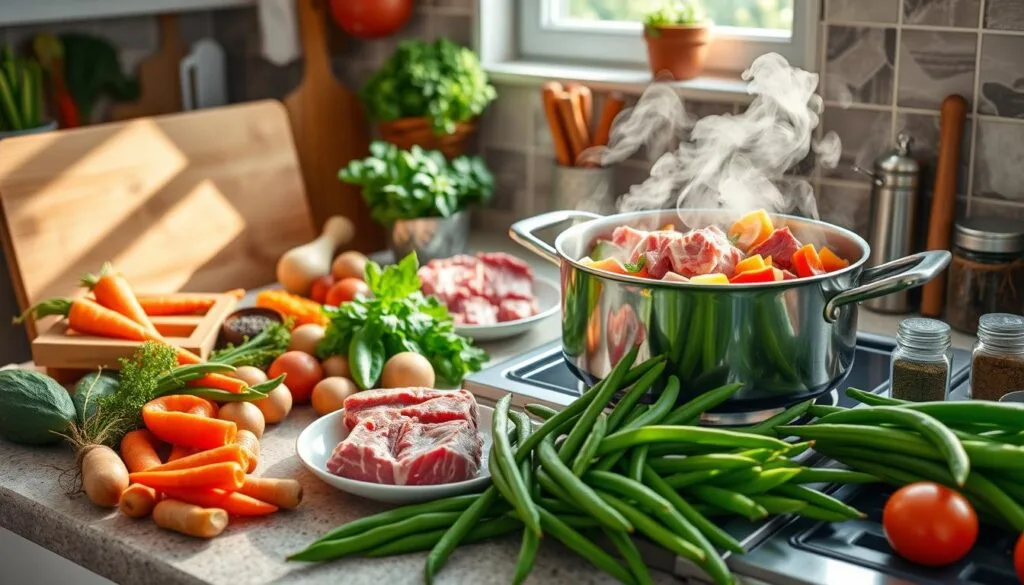
Smart prep strategies can cut down your cooking time a lot. Here are some ways to make your soup faster:
- Pre-chop veggies early and keep them in sealed containers
- Use a pressure cooker or Instant Pot for quicker cooking
- Make big batches and freeze some for later
- Get your ingredients ready before cooking (mise en place)
The mise en place method is great for quick cooking. It helps you organize and measure ingredients before cooking. This makes your cooking smoother and less stressful.
“Preparation is the key to quick and delicious meal creation.”
| Cooking Method | Prep Time | Total Cooking Time |
|---|---|---|
| Traditional Stovetop | 30 minutes | 1 hour 30 minutes |
| Instant Pot | 10 minutes | 40 minutes |
| Slow Cooker | 15 minutes | 6-8 hours |
By using these quick soup tips, you’ll make soup-making faster and more fun.
Enhancing Flavors with Herbs and Seasonings
Making a tasty vegetable beef soup is more than just ingredients. The right seasonings can turn a simple dish into a memorable meal. It warms your heart and excites your taste buds.
Choosing the right herbs and spices is key to rich flavors in your soup. Knowing which herbs to use can make your cooking stand out.
Essential Spice Combinations
When picking seasonings, try these classic mixes for depth in your soup:
- Thyme and bay leaves for earthy undertones
- Garlic powder and black pepper for warmth
- Rosemary and oregano for Mediterranean flair
Fresh Herb Options
Fresh herbs can really boost your soup’s taste. Here are some great choices:
| Herb | Flavor Profile | Best Used |
|---|---|---|
| Parsley | Fresh, bright | As garnish |
| Thyme | Earthy, slightly minty | During cooking |
| Rosemary | Robust, piney | With beef |
For the best taste, add dried herbs early to let their flavors out. Use fresh herbs as a garnish to keep their taste and smell alive.
“Herbs are the magic wands of cooking, transforming simple ingredients into extraordinary meals.” – Unknown Chef
Seasoning soup is an art. Start with a little, taste, and adjust to get the flavor just right.
Storage and Reheating Guidelines
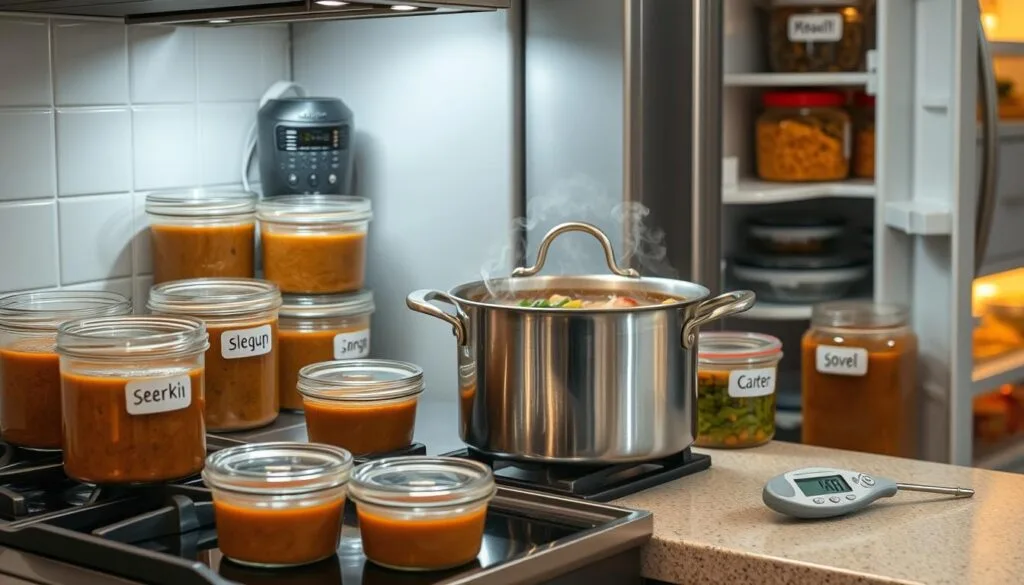
Properly storing soup lets you enjoy your vegetable beef soup for days. It’s important to use the right containers and follow safe practices. This keeps the flavor and food safe.
Refrigeration Tips
Here are some tips for storing soup in the fridge:
- Use airtight containers to prevent contamination
- Cool soup completely before refrigerating
- Store soup for maximum 5 days
- Keep refrigerator temperature below 40°F
Freezing Techniques
When reheating soup from frozen, be careful. Your soup can be safely frozen for up to 4 months if stored right.
| Storage Method | Duration | Recommended Action |
|---|---|---|
| Refrigeration | 3-5 days | Store in sealed container |
| Freezing | Up to 4 months | Use freezer-safe containers |
Reheating Soup Safely
When reheating soup, use gentle heat to keep its taste and texture. Stovetop reheating is best for quality.
- Thaw frozen soup overnight in refrigerator
- Transfer to pot
- Heat on medium-low temperature
- Stir occasionally
- Add small amount of broth if needed
“The key to great leftover soup is careful storage and gentle reheating.” – Culinary Expert
By following these guidelines, your vegetable beef soup will stay delicious and safe to eat for many meals.
Nutritional Benefits and Dietary Considerations
Your vegetable beef soup is more than just a tasty meal—it’s packed with nutrients. Knowing the soup’s nutrition helps you make better food choices. You can enjoy a hearty, healthy soup recipe.
Caloric Content and Macronutrients
A single serving of this soup is a nutritional powerhouse. Here’s a breakdown of the key nutrients:
| Nutrient | Amount per Serving |
|---|---|
| Calories | 400 kcal |
| Protein | 17g |
| Carbohydrates | 18g |
| Fat | 5g |
Dietary Modifications
This healthy soup recipe is very flexible. You can change it to fit different diets:
- Low-Sodium Version: Use reduced-sodium beef broth
- Gluten-Free Option: Replace pearl barley with quinoa
- Low-Carb Adaptation: Reduce root vegetables
- High-Protein Boost: Add extra lean beef or legumes
“Soup is a way to nourish both body and soul, with endless possibilities for customization.” – Culinary Nutritionist
Remember, your vegetable beef soup can be a nutritious meal. It supports your health goals and satisfies your taste buds.
Common Cooking Mistakes to Avoid
Making perfect vegetable beef soup means avoiding key mistakes. These mistakes can ruin the flavor and texture. Knowing these tips will help you make a delicious meal every time.
Key Mistakes to Prevent
- Overcooking Vegetables: Adding veggies too early makes them mushy and tasteless
- Skipping the meat searing process, which reduces depth of flavor
- Using incorrect meat cuts that become tough during cooking
- Under-seasoning the broth, leading to bland taste
Starting to avoid soup mistakes means learning the right cooking techniques. Chefs say searing meat before adding it to the soup is key. This creates rich, caramelized flavors through the Maillard reaction.
“The secret to an exceptional soup is patience and technique” – Professional Chef
Critical Cooking Techniques
| Mistake | Solution |
|---|---|
| Rushing Cooking Process | Simmer beef for at least one hour per pound of meat |
| Inconsistent Meat Cuts | Cut beef into uniform 1-inch cubes for even cooking |
| Incorrect Liquid Ratio | Ensure broth covers all ingredients completely |
When making vegetable beef soup, timing is everything. Add veggies after the meat has simmered for about an hour. This keeps them tender and prevents them from getting tough.
- Use recommended cuts like chuck roast or bottom round
- Brown meat before adding to the soup
- Add fresh herbs in the last 30 minutes of cooking
By following these tips and avoiding common mistakes, you’ll make a hearty, flavorful vegetable beef soup. It will impress your family and friends.
Conclusion
Making an easy vegetable and beef soup is more than cooking. It’s about bringing comfort into your life. You’ve shown how simple ingredients can become a warm meal quickly.
Using pre-cut beef and frozen veggies makes soups easy. You don’t need to spend hours in the kitchen. This makes delicious soups accessible to everyone.
Soup making is all about being flexible. You can make a hearty soup in two hours or a quick one in 30 minutes. Try different veggies, adjust the broth, and add your own spices. This way, your soup will be truly yours.
Storing your soup is a big plus. You can keep it in the fridge for up to 3 days or freeze it for 2-3 months. This means you always have a healthy meal ready.
By mastering these tips, you’ve learned more than just a recipe. You’ve discovered a way to cook that’s flexible and delicious. It brings warmth and joy to your meals.
We encourage you to share your vegetable beef soup stories. What changes have you made? What tips have you found? Your cooking journey is just starting, and every soup has its own tale.





